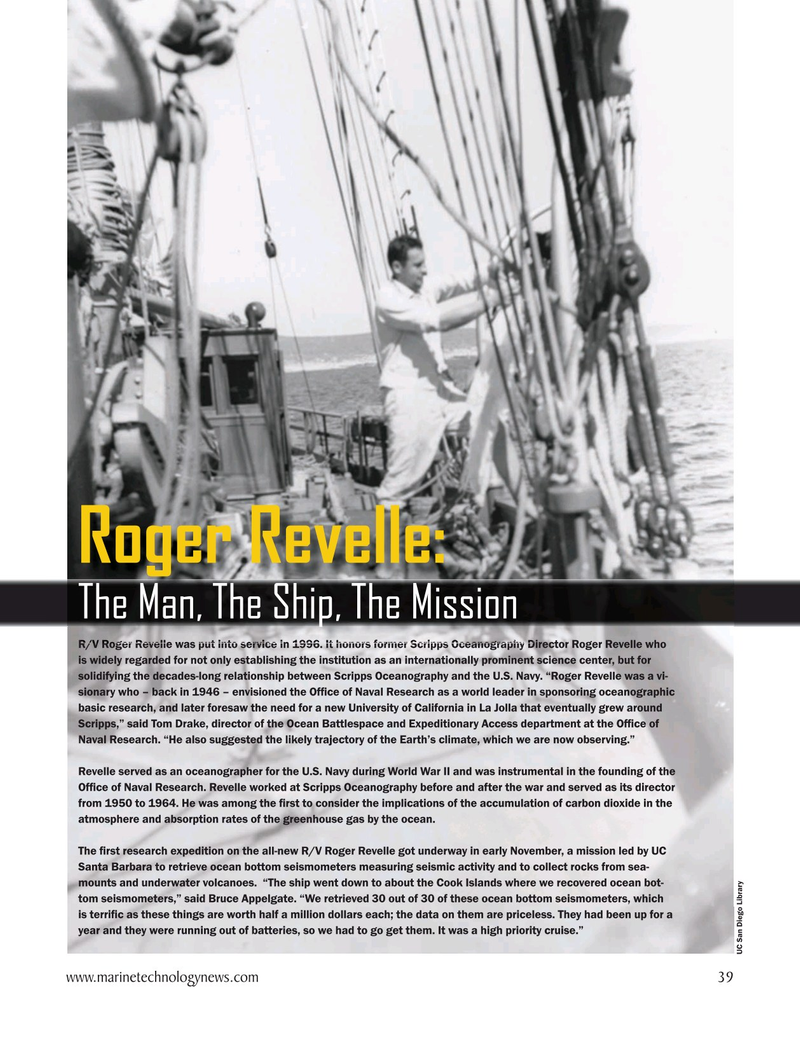
Page 39: of Marine Technology Magazine (January 2021)
Underwater Vehicle Annual
Read this page in Pdf, Flash or Html5 edition of January 2021 Marine Technology Magazine
Roger Revelle:
The Man, The Ship, The Mission p y ograph anog ph anog ph r er c i 1996 ce put pu g r R/ /V Rog g g g ge er Re e e e e eve ve ve vel ll l le was put t i into to o s se e e e e er r r e vi v v c c c ce e i i in 1996 It It h hon nor ors s fo form mer S S Scr cr crip ip ipps ps O O O O O Oc c c c ce eanogra ra ra a a a ap phy y y D D D D R/V Roger Revelle was put into service in 1996. It honors former Scripps Oceanography Director Roger Revelle who is widely regarded for not only establishing the institution as an internationally prominent science center, but for solidifying the decades-long relationship between Scripps Oceanography and the U.S. Navy. “Roger Revelle was a vi- sionary who – back in 1946 – envisioned the Of? ce of Naval Research as a world leader in sponsoring oceanographic basic research, and later foresaw the need for a new University of California in La Jolla that eventually grew around
Scripps,” said Tom Drake, director of the Ocean Battlespace and Expeditionary Access department at the Of? ce of
Naval Research. “He also suggested the likely trajectory of the Earth’s climate, which we are now observing.”
Revelle served as an oceanographer for the U.S. Navy during World War II and was instrumental in the founding of the
Of? ce of Naval Research. Revelle worked at Scripps Oceanography before and after the war and served as its director from 1950 to 1964. He was among the ? rst to consider the implications of the accumulation of carbon dioxide in the atmosphere and absorption rates of the greenhouse gas by the ocean.
The ? rst research expedition on the all-new R/V Roger Revelle got underway in early November, a mission led by UC
Santa Barbara to retrieve ocean bottom seismometers measuring seismic activity and to collect rocks from sea- mounts and underwater volcanoes. “The ship went down to about the Cook Islands where we recovered ocean bot- tom seismometers,” said Bruce Appelgate. “We retrieved 30 out of 30 of these ocean bottom seismometers, which is terri? c as these things are worth half a million dollars each; the data on them are priceless. They had been up for a year and they were running out of batteries, so we had to go get them. It was a high priority cruise.”
UC San Diego Library www.marinetechnologynews.com 39
MTR #1 (34-49).indd 39 1/25/2021 8:40:29 AM

 38
38

 40
40
